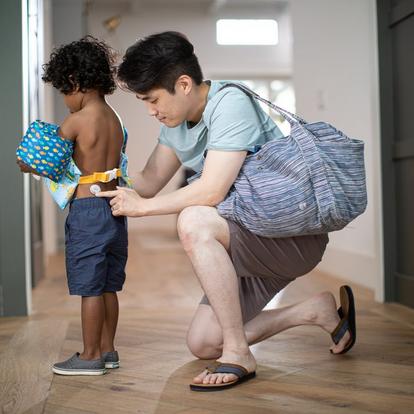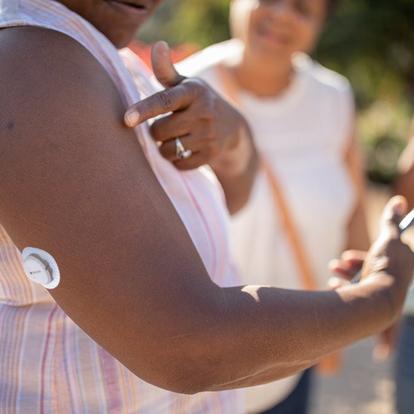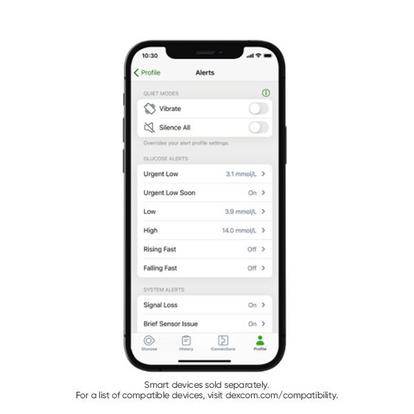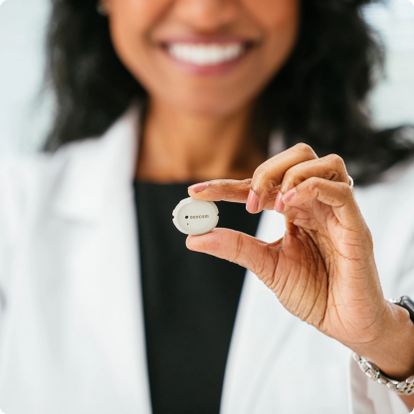
Dexcom G7 vs FreeStyle Libre 2: Choosing the Right CGM
Get a comparison of Dexcom G7 vs FreeStyle Libre 2 to explore which glucose monitoring system fits your needs.
The Dexcom G7 Continuous Glucose Monitoring (CGM) System makes it possible to get accurate glucose readings without regular fingersticks.* Similar technology, such as the FreeStyle Libre 2 system, can also provide a view into glucose levels without using a blood glucose meter. While Dexcom G7 and FreeStyle Libre 2 both support glucose monitoring and management for those living with diabetes, the features and benefits of these systems aren’t the same.
Everyone experiences diabetes in their own unique way and no two people have the same needs when it comes to CGM. Comparing the latest CGM technology gives you the opportunity to explore which system might fit best with your lifestyle and your diabetes management goals.
What do Dexcom systems have that FreeStyle Libre devices don’t?
Dexcom G7 shares several features with its predecessor, Dexcom G6.
There are a few important features that these Dexcom CGM systems
have in common that aren’t found in FreeStyle Libre systems.
There are a few important features that these Dexcom CGM systems
have in common that aren’t found in FreeStyle Libre systems.

1. More Options for Sensor Placement
✓ Dexcom G7 can be worn on the back of the arm or lower abdomen and kids from two to six can also wear it on their upper buttocks. Similarly, adults can wear Dexcom G6 on the back of the arm or the lower abdomen while kids from two to 17 can wear it on their upper buttocks or the lower abdomen.†
𝗫 FreeStyle Libre sensors are only approved to be worn on the back of the arm.1

2. Supports broader range of people
✓ Dexcom CGM Systems are also approved for the broadest range of people who live with type 1 diabetes or type 2 diabetes. Dexcom can be used by children as young as two. Dexcom G7 is also the only CGM system that’s approved in Canada for use during pregnancy and for those experiencing gestational diabetes.
𝗫 FreeStyle Libre devices currently available in Canada can only be used by individuals over four years old and the devices have not been approved for use during pregnancy.

3. Can Let You Know Before You Go Low
✓ Dexcom CGM Systems offer a predictive Urgent Low Soon alert that can let you know whether you’re headed for a serious low below 3.1 mmol/L within the next 20 minutes.
𝗫 FreeStyle Libre systems alert you the moment you reach your set high and low thresholds, not before.

4. Provides Alerts That Fit Your Lifestyle
✓ Dexcom G6 and Dexcom G7 allow you to create a schedule that automatically switches your alert settings during a specified period of time—such as when you’re in a meeting.
𝗫 FreeStyle Libre systems do not offer an alert schedule feature.1
Dexcom G7 vs FreeStyle Libre 2
Both Dexcom G7 and FreeStyle Libre 2 take glucose readings via a sensor that’s worn on the body and send them to a display device so you can view glucose levels in the palm of your hand. Though there are some similarities between the two systems, they offer very different glucose monitoring experiences.
Accuracy and Overall Effectiveness
Real-Time Continuous Glucose Monitoring
Sensor Application
Sensor Wear
Glucose Alerts and Alarms
Dexcom G7 and FreeStyle Libre 2 both have alerts or alarms that can notify you when your glucose levels are high or low. Dexcom G7 has a wider range of customizable alerts and a built-in Urgent Low Alert that are designed to help you take proactive action to help increase time in your target range (generally defined by Diabetes Canada as 3.9–10.0 mmol/L6) and decrease highs and lows.
Dexcom G7 alerts are designed to help reduce notification fatigue so that receiving notifications is more convenient—and effective. Only use the alerts that you find most supportive throughout your day. The app has a large library of alert sounds, so you can select which ones you like best.
Here are some key alerts and alarm features exclusive to Dexcom CGM Systems:
On the other hand, FreeStyle Libre 2 low alerts only notify you when the thresholds you’ve set have been reached.1 However, the predictive Urgent Low Soon alert with Dexcom G7 can sound 20 minutes before you hit 3.1 mmol/L so you can treat lows ahead of time and even treat hypoglycemia at night. Get some additional piece of mind while you sleep, knowing that Dexcom G7 can alert you ahead of your low.
Find Out if Dexcom G7 is the Right CGM for You
Dexcom G7 is designed to support the way you manage diabetes. Its flexible features make it easy to personalize the experience so that you can get the most out of CGM technology and monitor your glucose levels with greater confidence.

Talk to your healthcare provider about getting started
Dexcom CGM is covered by most public and private insurers for people living with type 1 diabetes and type 2 diabetes using rapid-acting insulin.# Talk to your healthcare provider about switching to Dexcom G7.
* If your glucose alerts and readings from the Dexcom CGM do not match symptoms or expectations, use a blood glucose meter to make diabetes treatment decisions.
† Sensors worn on the back of the upper arm have been found to be slightly more accurate than sensors worn on the abdomen.
‡ When compared with CGM systems commercially available in Canada as of October 2023.
§ For a list of compatible smart devices, please visit dexcom.com/compatibility.
|| Patients reported 94% of insertions were painless (mild, no pain).
# Dexcom data on file, 2023. Individual benefits may vary by policy and plan.
1 FreeStyle Libre 2 User Guide.
2 Dexcom, data on file, 2023.
3 Brown RE, et al. Diabet Med. 2022;39(11):e14937. doi: 10.1111/dme.14937
4 LibreLinkUp website. Accessed August 28 2023. https://www.librelinkup.com/faqs
5 Dexcom G7 User Guide.
6 Imran SA, et al. Can J Diabetes. 2018;42 Suppl 1:S42-S6.
7 Beck RW, et al. JAMA. 2017;317(4):371-378.
8 Beck RW, et al. Ann Intern Med. 2017;167(6):365-374.
9 Martens T, et al. JAMA. 2021;325(22):2262-2272.
10 Laffel LM, et al. JAMA. 2020;323(23):2388-2396.
11 Welsh JB, et al J Diabetes Sci Technol. 2024;18(1):143-7.
12 Heinemann L, et al. Lancet. 2018;391(10128) :1367-1377.
† Sensors worn on the back of the upper arm have been found to be slightly more accurate than sensors worn on the abdomen.
‡ When compared with CGM systems commercially available in Canada as of October 2023.
§ For a list of compatible smart devices, please visit dexcom.com/compatibility.
|| Patients reported 94% of insertions were painless (mild, no pain).
# Dexcom data on file, 2023. Individual benefits may vary by policy and plan.
1 FreeStyle Libre 2 User Guide.
2 Dexcom, data on file, 2023.
3 Brown RE, et al. Diabet Med. 2022;39(11):e14937. doi: 10.1111/dme.14937
4 LibreLinkUp website. Accessed August 28 2023. https://www.librelinkup.com/faqs
5 Dexcom G7 User Guide.
6 Imran SA, et al. Can J Diabetes. 2018;42 Suppl 1:S42-S6.
7 Beck RW, et al. JAMA. 2017;317(4):371-378.
8 Beck RW, et al. Ann Intern Med. 2017;167(6):365-374.
9 Martens T, et al. JAMA. 2021;325(22):2262-2272.
10 Laffel LM, et al. JAMA. 2020;323(23):2388-2396.
11 Welsh JB, et al J Diabetes Sci Technol. 2024;18(1):143-7.
12 Heinemann L, et al. Lancet. 2018;391(10128) :1367-1377.
